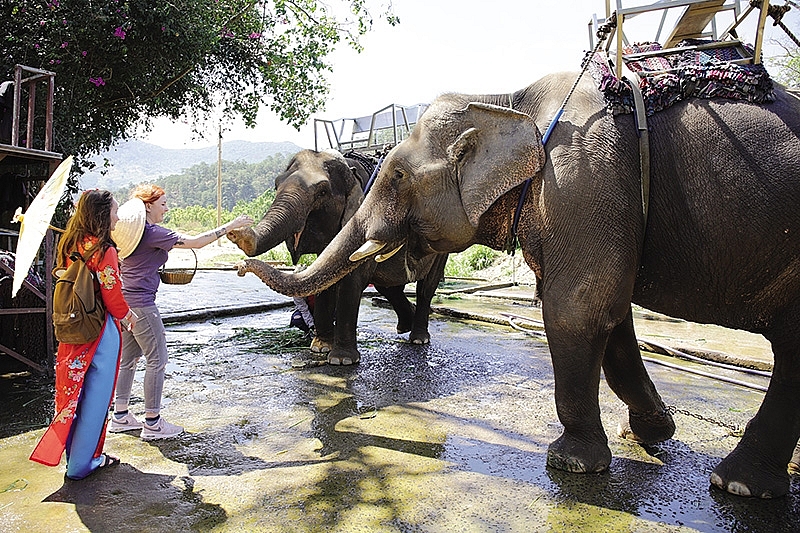Despite the convergence of many opportunities in the fields of agriculture, processing, clean energy, and tourism, the Central Highlands region is still facing plenty of challenges as it aims to become one of seven key tourist areas of Vietnam by 2020.

Bidoup Nui Ba could be integral for the Central Highlands
The region is one of six major economic zones in Vietnam, including the five provinces of Kon Tum, Gia Lai, Dak Lak, Dak Nong, and Lam Dong, covering a natural area of 54,474 square kilometres and accounting for 16.8 per cent of the nation’s natural area. The region is famous for its reserves of mineral resources and industrial cultivation of crops currently accounting for a large proportion of Vietnam’s agricultural exports such as coffee, rubber trees, and pepper.
However the tourism sector, another precious resource for the Central Highlands, has not yet been fully tapped into. With diverse terrain from high mountains to large valleys, the region enjoys a cool climate all year round, has many attractive natural landscapes with high biological value, and is also home to 47 ethnic minority groups with unique local cultures.
In 2017, provinces in the region attracted around 1.9 million visitors, an increase of 9 per cent over the same period in 2016, while the number of domestic and international visitors increased by 6.6 and 2.4 per cent, respectively, reaching over VND2.9 billion ($126,100) in total revenue, an increase of nearly 14 per cent on-year. In particular, Lam Dong is still the province with the highest number of tourists in the region, accounting for 78.3 per cent, followed by Dak Lak.
The Central Highlands is now focusing on developing various types of tourism including adventure, ecotourism, and resort tourism. As one of the five largest national parks in Vietnam, Bidoup Nui Ba National Park has been selected as the focal point for ecotourism development in Lam Dong, in partnership with Japan International Co-operation Agency (JICA) in testing six tourist routes for sightseeing and adventure tourism. Large-scale festival programmes held over the past few years have gradually become peculiar tourism products in some localities in the area such as the Gong festival, Elephant racing festival, and the Dalat flower festival. Such unique types of tourism such as weekend vacations, honeymoons, mountain and lake tours, agricultural tours with attractive activities like elephant riding, kayaking, and swimming are successfully operated. In addition, tours visiting historical monuments, experiencing coffee farm homestays, and learning about culture in ethnic minority villages are also popular among tourists.
Statistics from the Vietnam National Administration of Tourism show that international tourists to the Central Highlands mainly consists of French, accounting for 23-25 per cent. This is followed by the United States, China, and the UK. Furthermore, the region has welcomed a number of international tourists travelling by caravan through Le Thanh and Bo Y border gates.

The Central Highlands region is looking for a unique selling point which it can use to brand itself to international visitors
Links to go further
Although each province in the Central Highlands has certain advantages, there is a lack of vertical connectivity between them, and links with coastal provinces to develop regional products is still shaky.
Ha Cong Ninh, a tour guide in Dalat, said that his company had surveyed and piloted some tours from Ho Chi Minh City to Dalat then to Dak Lak, but tourists are only satisfied with the Dalat half of the itinerary. “Tourism products in Dak Lak are unique, but many of them are duplicated with some Dalat tourist spots so they fail to attract much interest,” Ninh said.
According to Nguyen Thi Bich Ngoc, deputy director of the Lam Dong Department of Culture, Sports and Tourism, provinces in the region need to join hands to highlight indigenous cultural space and specific tourism products for each locality. At the Conference on Tourism Development in the Central Highlands Region held recently in the central city of Hue with the participation of 19 cities and provinces, the issue of linking to create common regional tourism products was also supported by local representatives.
The most important issue attracting the attention of investors is in transport infrastructure. Currently, Central Highland provinces invest in construction of tourist spots and transportation systems to better serve the travel needs of tourists. Lien Khuong Airport has been invested and built according to the 4D level standard which is qualified to serve over two million passengers annually. The airport has operated six domestic routes to Ho Chi Minh City, Haiphong, Danang, Hanoi, Hue, and Vinh with a frequency of 27 flights per day. It also runs two regular international routes to Bangkok and Wuhan, along with charter flights to Singapore and South Korea with a frequency of 32 flights per day. Lien Khuong served 1.53 million passengers in 2017, 0.65 million passengers in the first six months of 2018, an increase of 36 per cent over the same period previous years.
In the near future, the roads, highways, airports, and railways connecting the central coast with the Central Highlands will see further investment to build connections between tours, thereby expanding co-operation with heritage sites in Laos and Cambodia in order to create an Indochina tourism product chain.
The Central Highlands provinces are also stepping up activities in promoting tourism related to socialisation, close co-operation with local and international media and news agencies, as well as international and domestic flights to attract many more tourists.
VIR